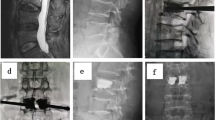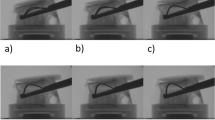Abstract
Percutaneous kyphoplasty (PKP) has been used to treat osteoporotic vertebral compression fractures for over 10 years; however, clinically speaking it is still controversial as to whether the use of unipedicular PKP or bipedicular PKP is best. Our study aimed to compare the different effects of unipedicular PKP and bipedicular PKP on the stiffness of compression fractured vertebral bodies (VBs), as well as to assess how cement distribution affect the bilateral biomechanical balance of the VBs. During this study, 30 thoracic VBs were compressed, creating vertebral compression fracture models; then they were augmented by unipedicular (group A and B) PKP and bipedicular (group C) PKP. In group A (unipedicular PKP), the cement was injected into one side and the augmentation was limited to the same side of the VB. In group B (unipedicular PKP), the cement was injected at only one side but the augmentation extended across the midline and filled both sides of the VB. In group C (bipedicular PKP), the cement was injected into both sides and thus achieved the bilateral augmentation. For the unipedicular PKP, the amount of cement injected was 15% of the original VB volume; while in bipedicular PKP, the amount of cement injected was a total of 20% of the original VB volume (10% was injected into each side). Using a MTS-858, we examined three phases of the VBs (intact, pre-augmented, post-augmented), by applying loads axially to the total vertebra and bilateral sides of the vertebra for each of three cycles, respectively. The changes of force and displacement were then recorded and the stiffness of the total vertebra and bilateral sides of the vertebra were calculated. For the pre-augmentation stage, the total VB stiffness of groups A, B and C significantly decreased when the compression fracture models were established (P < 0.05). After the cement augmentation (the post-augmentation stage), both groups A and B, showed that the stiffness could be restored to the initial, intact state; however, in group C, the stiffness was significantly higher than the initial, intact state (P < 0.01). The stiffness of the augmented side of group A was significantly higher than the non-augmented side (P < 0.001). In groups B and C, no significant differences were observed in the stiffness between total VB and each individual side. Thus, we can conclude that both unipedicular PKP and bipedicular PKP significantly increase the total VB stiffness. Bipedicular PKP creates stiffness uniformly across both sides of the vertebrae, while unipedicular PKP, creates a biomechanical balance depending on the distribution of cement. If bone cement is augmented only on one side, the stiffness of non-augmented side will be significantly lower than the augmented side, which might lead to an imbalance of stress on the VB. However, when cement augmentation crosses the midline, stiffness of both sides increase comparatively and biomechanical balance is thus achieved.






Similar content being viewed by others
References
Al-Ali F, Barrow T, Luke K (2009) Vertebroplasty: what is important and what is not. Am J Neuroradiol 30(10):1835–1839
Belkoff SM, Mathis JM, Jasper LE, Deramond H (2001) The biomechanics of vertebroplasty: the effect of cement volume on mechanical behavior. Spine 26(14):1537–1541
Boszczyk B (2010) Volume matters: a review of procedural details of two randomized controlled vertebroplasty trials of 2009. Eur Spine J 19:1837–1840
Buchbinder R, Osborne RH, Ebeling PR, Wark JD, Mitchell P, Wriedt C, Graves S, Staples MP, Murphy B (2009) A randomized trial of vertebroplasty for painful osteoporotic vertebral fractures. N Engl J Med 361(6):557–568
Chang WS, Lee SH, Choi WG, Choi G, Jo BJ (2007) Unipedicular vertebroplasty for osteoporotic compression fracture using an individualized needle insertion angle. Clin J Pain 23(9):767–773
Furtado N, Oakland RJ, Wilcox RK, Hall RM (2007) A biomechanical investigation of vertebroplasty in osteoporotic compression fractures and in prophylactic vertebral reinforcement. Spine 32(17):480–487
Fyhrie DP, Vashishth D (2000) Bone stiffness predicts strength similarly for human vertebral cancellous bone in compression and for cortical bone in tension. Bone 26(2):169–173
Hulme PA, Krebs J, Ferguson SJ, Berlemann U (2006) Vertebroplasty and Kyphoplasty: a systematic review of 69 clinical studies. Spine 31(17):1983–2001
Hou FJ, Lang SM, Hoshaw SJ, Reimann DA, Fyhrie DP (1998) Human vertebral body apparent and hard tissue stiffness. J Biomech 31(11):1009–1015
Kallmes DF, Comstock BA, Heagerty PJ, Turner JA, Wilson DJ, Diamond TH, Edwards R, Gray LA, Stout L, Owen S, Hollingworth W, Ghdoke B, Annesley-Williams DJ, Ralston SH, Jarvik JG (2009) A randomized trial of vertebroplasty for osteoporotic spinal fractures. N Engl J Med 361(6):569–579
Kaufmann TJ, Trout AT, Kallmes DF (2006) The effects of cement volume on clinical outcomes of percutaneous vertebroplasty. AJNR Am J Neuroradiol 27(9):1933–1937
Keaveny TM, Wachtel EF, Ford CM, Hayes WC (1994) Differences between the tensile and compressive strengths of bovine tibial trabecular bone depend on modulus. J Biomech 27(9):1137–1146
Ken K, Kenji T, Masamichi K, Misako Y, Shinjiro S, Yasuo N (2006) Unilateral transpedicular percutaneous vertebroplasty using puncture simulation. Radiat Med 24(3):187–194
Kim MJ, Lindsey DP, Hannibal M, Alamin TF (2006) Vertebroplasty versus kyphoplasty: biomechanical behavior under repetitive loading conditions. Spine 31(18):2079–2084
Liebschner MAK, Rosenberg WS, Keaveny TM (2001) Effects of bone cement volume and distribution on vertebral stiffness after vertebroplasty. Spine 26(14):1547–1554
Luo J, Daines L, Charalambous A, Adams MA, Annesley-Williams DJ, Dolan P (2009) Vertebroplasty: only small cement volumes are required to normalize stress distributions on the vertebral bodies. Spine 34(26):2865–2873
McGirt MJ, Parker SL, Wolinsky JL, Witham TF, Bydon A, Gokaslan ZL (2009) Vertebroplasty and kyphoplasty for the treatment of vertebral compression fractures: an evidenced-based review of the literature. Spine J 9(6):501–508
Molloy S, Mathis JM, Belkoff SM (2003) The effect of vertebral body percentage fill on mechanical behavior during percutaneous vertebroplasty. Spine 28(14):1555–1559
Papadopoulos EC, Osula FE, Gardner MJ, Shindle MK, Lane JM (2008) Unipedicular Balloon Kyphoplasty for the Treatment of Osteoporotic Vertebral Compression Fractures:Early Results. J Spinal Disor Tech 21(8):589–596
Steinmann J, Tingey CT, Cruz G, Dai Q (2005) Biomechanical comparison of unipedicular versus bipedicular kyphoplasty. Spine 30(2):201–205
Tohmeh AG, Mathis JM, Fenton DC, Levine AM, Belkoff SM (1999) Biomechanical efficacy of unipedicular versus bipedicular vertebroplasty for the management of osteoporotic compression fractures. Spine 24(17):1772–1776
Walz M, Esmer E, Kolbow B (2006) CT-based analysis of cement distribution in unipedicular vertebroplasty. Der Unfallchirurg 109(11):932–939
Wardlaw D, Cummings SR, Meirhaeghe JV, Bastian L, Tillman JB, Ranstam J, Eastell R, Shabe P, Talmadge K, Boonen S (2009) Efficacy and safety of balloon kyphoplasty compared with non-surgical care for vertebral compression fracture (FREE): a randomised controlled trial. Lancet 373(9668):1016–1024
Zou J, Yang HL, Lee S (2009) Single balloon vs double balloon kyphoplasty for treatment of osteoporotic vertebral compression fractures. Spine J 9(10):100 Abstract
Acknowledgments
This program was funded by Guangdong Provincial Science and Technology Foundation in 2009. NO. 2009B030803034. Thanks for the help of Deanna Fuller in improving the English language of this paper.
Conflict of interest
None.
Author information
Authors and Affiliations
Corresponding author
Additional information
B. Chen and Y. Li contributed equally to this research, and both are first co-authors.
Rights and permissions
About this article
Cite this article
Chen, B., Li, Y., Xie, D. et al. Comparison of unipedicular and bipedicular kyphoplasty on the stiffness and biomechanical balance of compression fractured vertebrae. Eur Spine J 20, 1272–1280 (2011). https://doi.org/10.1007/s00586-011-1744-3
Received:
Revised:
Accepted:
Published:
Issue Date:
DOI: https://doi.org/10.1007/s00586-011-1744-3




